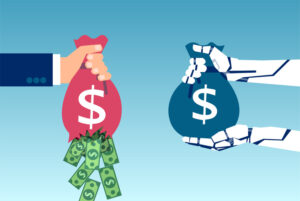
Back in 2019, Artificial Intelligence (AI) was still just a gleam in investors’ eyes.
It promised that one day be able have an intelligent conversation with a machine.
It could write a sonnet… draft a legal document… or compose music.
Microsoft (NYSE: MSFT) invested $1 billion in an artificial intelligence company called Open AI. That was four years ago – and nobody gave it much thought.
Then OpenAI released ChatGPT. And Microsoft invested an additional $10 billion.
Microsoft was staking its claim on one of the most powerful innovations to come along in decades.
By now I guess it’s inevitable that you’ve heard something about ChatGPT. It’s likely you know a little about what it can do – you may have even tried it out. After all, ChatGPT has well over 100 million users already…
That 100 million is probably a low-ball estimate. Because Microsoft has embedded ChatGPT into its Bing! search engine.
Plus, Google (NASDAQ: GOOG) created its own chatbot called Bard. And Amazon (NASDAQ: AMZN) is offering AI services to its cloud customers.
AI chatbot’s like ChatGPT are called “generative AI.”
When you ask it a question, it “generates” a complete answer by searching basically the entire internet and extracting the relevant information to create a detailed response.
This first iteration of AI has already made some investors a lot of money.
Shares of Nvidia (NASDAQ: NVDA) are up 213% so far this year. Google has managed a respectable 57% gain. And if you bought into Microsoft as it was securing its access to ChatGPT AI back in January – you’re up almost exactly 50%.
Not too shabby…
But these gains pale in comparison to what’s coming next.
Because just as today’s generative AI uses massive processing power to create detailed reports, legally useful documents and contracts, time saving systems monitoring – Predictive AI is already being used to forecast – and profit from – stock price moves.
Start Using Predictive AI to Spot the Top Trades
Trying to predict the stock market’s next move is nothing new.
Whether its analysts predicting next year’s earnings for a company, economists forecasting economic growth, or trading algorithms that drive most of the daily stock trading volume on the New York Stock Exchange, the basic idea is the same: plug in as many variables as you can and get a useful forecast.
The success that huge trading firms like AQR and Renaissance Capital have had with predictive trading algorithms have turned their founders into billionaires many times over.
Today AI has the power to process millions of data points in a split-second. And that means Predictive AI can now forecast stock moves with at least 80% accuracy.
Imagine what knowing in advance which way shares of Apple or Tesla will move next week – with 80% or 90% accuracy. You could probably make some money with that information, right?
The best part is that Predictive AI for stock prices is no longer available only to Wall Street firms like AQR or Renaissance Capital.
The AI boom means that regular investors now have access to the same type of Predictive AI that those Wall Street firms use to make consistent and reliable profits.
Brit Ryle
 Facebook
Facebook
 Twitter
Twitter